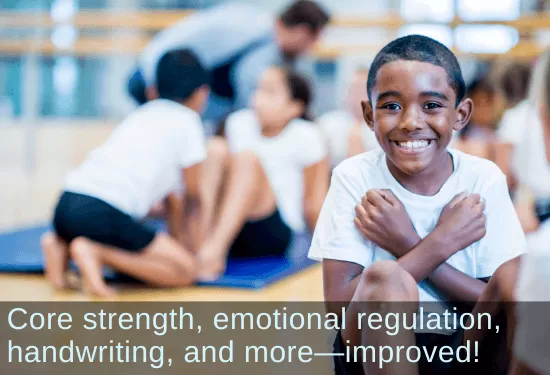Primitive Reflex Integration Case Studies
“Watch Mommy! I Can Do a Sit Up!!”
Rhythmic movements and reflex integration help with a range of issues around auditory processing, core strength, and emotional regulation.
After recovering from diagnoses of PDD-NOS, apraxia, and hypotonia, this child still struggled with core strength, emotional regulation, auditory processing, occasional toileting accidents, and pencil grip. See how several weeks of rhythmic movements and reflex integration resulted in huge changes in all of these areas.
Submitted by CD, parent

| Before | After |
|---|---|
| Difficulty lifting head | Now able to do complete sit-ups |
| Difficulty with pencil grip | More relaxed pencil grip and improved handwriting |
| Emotional dis-regulation | Calmer |
| Frequent “leaking” accidents during sports | No more toileting accidents |
| Auditory processing issues | Improved auditory and conversation skills |
My son was diagnosed with several conditions: PDD-NOS, apraxia, and hypotonia at 18 months … but five years ago, at age 4, my son Jonah recovered from all of his diagnoses.
"However, because of these developmental difficulties he suffered as a child, he still struggled with attention, emotional regulation, auditory processing, and making eye contact, among other things."
I then undertook an intensive reflex integration session with him daily, [using the neuro-movements from the Brain and Sensory Foundations course]. He has improved so much in a ton of areas. I’ll share with you just a few examples.
For the TLR reflex, when I first asked him to do the integration reflexes, I had to be careful supporting his head because it was hard for him to lift and he looked as if, at any minute, he might drop it to the floor with a crash.
"After a few weeks of doing TLR [Tonic Labyrinthine Reflex] every day (plus all the other reflexes) he one day did a complete sit-up. He was so shocked he hollered with a big grin “watch mommy! I can do a sit-up!!”
He was 8 years, 11 months, and had never been able to do that before. He’s been working on TLR constantly, and now, for his sports team they have a contest of how many sit-ups you can do in one minute, and he’s been working on that for a month. Yesterday, he did 38 sit-ups in one minute!!! But just 6 months ago, before we did the program, he couldn’t do one sit up. It was a strain to lift his head up for 10 seconds.
Another area where he is improving is his pencil grip. We did both hand reflex exercises, which worked for us both. The hand exercises have really helped him not grasp the pencil with so much force, and his handwriting is looking so much better.
"He used to have lots of emotional dis-regulation, but now he’s calmer. His balance has improved. His eye contact has improved, as has his auditory processing and conversation skills. He used to have 'leaking' accidents all the time during sports, now he never has a problem with that."
[Edited for length and clarity; emphasis added]
*Disclaimer: The activities in the Brain and Sensory Foundations curriculum make use of the natural processes of neuroplasticity and development that are innately wired in the design of human beings to promote maturity and function. These activities appear to calm, organize, and mature the neuro-sensory-motor systems just as we see in the healthy development of human infants. Individual results may vary, and we do not claim to offer a diagnosis or cure for any specific condition or disorder. The Brain and Sensory Foundations activities appear to improve overall functioning resulting in measurable improvements for a range of conditions as demonstrated in over 1800 case studies from participants.

